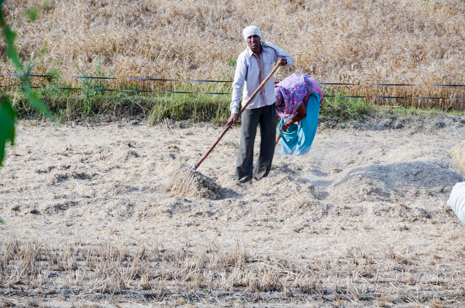In India, a devastating harvest season for northern farmers puts lives at risk
Devinder Bhardwaj was hoping for a bumper crop on his modest four-acre (1.6 hectare) plot of land. The profits from selling his wheat in the market, he hoped, would provide a much-needed injection to his family’s savings. But this year, unseasonal rains and hailstorms washed away his plans.
“The whole crop was under water due to the rains. Not even a single grain was left,” said Bhardwaj, who hails from a small village in northern India’s Haryana state.
It meant the farmer wasn’t even able to grow enough to feed his family. “Even for household consumption, we will have to buy wheat from outside,” he said.
Bhardwaj is not alone. He is among millions of farmers in the northern Indian states, including Haryana, Punjab and Uttar Pradesh, who have seen unseasonal early rains play havoc with their crops.
According to a survey conducted by the Haryana government, rains damaged 1.3 million acres of land in the state during the usual harvest season of March and April — a figure that accounts for one-fifth of the state’s total farmland.
In Punjab, 850,000 acres of agricultural land were damaged due to the rains, which are rarely expected so early in the year, particularly in India’s north.
Bhardwaj said that wheat is generally sown between the end of November and the beginning of December before being harvested in April. Ideally, a healthy January rainfall and the heat of March are beneficial for the crop.
“But this year,” he said, “the sudden rains damaged the wheat grain when it was almost ready for harvesting.”
'We will have to leave farming'
Even for farmers who have managed a limited yield from their crops, it is still a challenge to sell their produce at market, since the rain damage means it is often of a lower quality.
In an April report, the Food Corporation of India, a government body, said that 60 percent of wheat that had arrived at market in Haryana had sustained high damage.
Farmer Vinod Dalal told ucanews.com that his fields’ productivity this year has been more than halved because of the rains, and what crop he has managed to salvage is practically worthless at market.
“The wheat grain has turned black because of excess water. The yield is kept at home as there are not takers of such a crop in the market,” Dalal said.
Dalal’s family has lived off the land for generations. But if this volatility continues, he said, “we will have to leave farming and look for other jobs”.
For now, Dalal’s secondary job as a factory security guard helps keep the family afloat. Other families who are completely dependent on agriculture have not been so lucky.
Before planting season, Balwan Singh took out a sizeable loan to fund this year’s crop. Now, he said, he’s lost so much he’s not even sure he can pay the interest on that loan.
“The household expenses are also haunting me,” he said.

Balwan Singh works in his field in Haryana state (Photo by Ritu Sharma)
Across the country, devastation on affected farmers continues to take a severe toll. According to media reports, more than 80 farmers ended their own lives in India during March and April.
Individual state governments have announced compensation for farmers who have suffered crop damage. But many farmers say the money is far short of what’s needed.
Haryana’s government, for example, has announced compensation of up to the equivalent of US$190 per acre to farmers whose crops have sustained total damage, and US$110 for partial damage. The Punjab government has offered US$127 per acre for affected farms.
But Dalal said the compensation must be at least US$240 to meet farmers’ needs. And in any case, he’s still waiting for the government to follow through with its promise.
“The officers have come and done the survey but it is uncertain when we will get the money. We just have to wait,” he said.
A S Rajput, a scientist at the regional center of organic farming under the Federal Minister of Agriculture, told ucanews.com that this season’s crop loss should be a serious concern to more than just the farmers who are directly affected.
“Crop loss, especially wheat, is going to lead to inflation as there will be an imbalance between the demand and supply,” Rajput said.
He said farmers must adopt new agriculture strategies, such as diversifying what they plant, so that if one crop fails, others may help make up for the losses.
Farmers, too, say they have felt the need for change. But new ways of thinking are already too late for this year’s harvest.
“It will be hard to leave the methods that we have been practicing for generations,” Dalal said.
Ritu Sharma, New Delhi
Source: ucanews.com (May 20, 2015)

